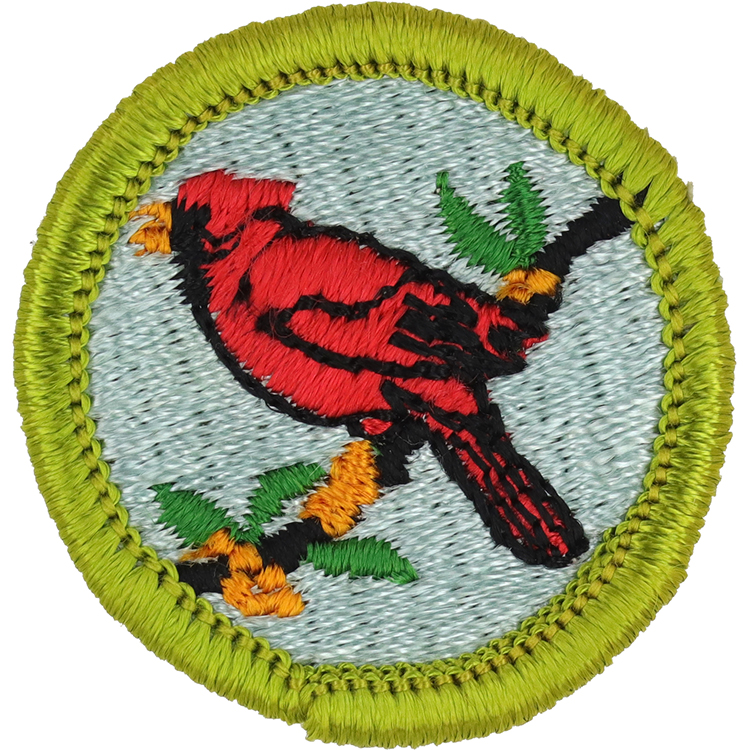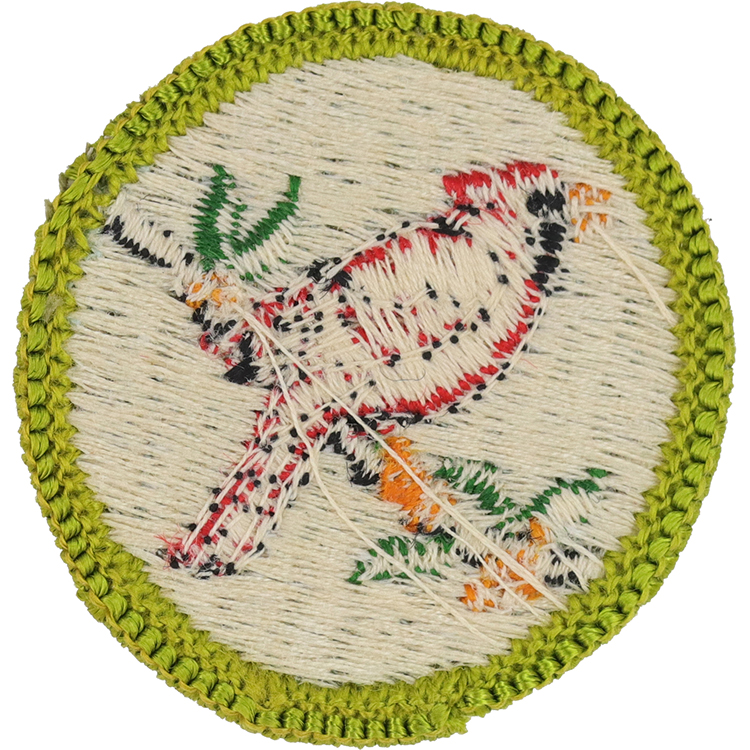
Fig. 1: BirStu-G-Front
- Embroidery: Cotton thread
- Border: Merrowed

Fig. 2: BirStu-G-Reverse
- Back: Starched cloth
Item Name: Bird Study 1969 - 1972
Item ID: BirStu-G
Collector Rating: 1
Requirements January 1969 until June 1972
1. Spend at least 3 hours in each of two different kinds of natural habitats at different elevations (field or prairie, forest, marsh, etc.) and make a list of the different bird species and individual numbers which you identified by yourself. Tell why all birds do not live in the same kind of habitat.
2. Spend 3 hours on each of 5 days on at least a 25-acre area, and make a list of bird species and numbers which you identified by sound or sight.
3. Recognize by sound alone 10 birds found in your locality.
4. From reading and talks with your counselor, make as complete a list as possible of the bird families usually found in your locality in the course of a year. Identify in the field one bird from eight of the following families: Pigeons and Doves; Woodpeckers; Tyrant Flycatchers; Swallows; Crows, Magpies, and Jays; Titmice, Bushtits; Wrens; Thrashers, Solitaires, Bluebirds; Wood Warblers; Weaver Finches; Blackbirds, Orioles, Meadowlarks; Finches, Sparrows, Grosbeaks, and Crossbills. Also identify on bird from any other six families.
5. From personal observation and reading, write a life history story of five hundred words on one bird other than a game bird that nests in your locality.
6. Do ONE of the following six projects:
(a) Keep accurate records of birds observed on at least eight field trips during one season (3 months).
(b) Watch a bird nest for an hour a day for 10 days and describe what you saw.
(c) Go on a Christmas census of at least 8 hours with a bird club and present a list of birds observed.
(d) Go on a May big day* of at least 8 hours with an expert and present a list of birds observed.
(e) Visit a federal, state or private bird refuge and describe its purpose and management techniques.
(f) Write a five hundred word life history of a game bird that nests in your locality.
7. Do ONE of the following five projects:
(a) Develop a backyard sanctuary of at least a tenth of an acre (planting trees and shrubs for food and cover) and describe what birds you expect to attract and why.
(b) Build three bird feeders of different kinds, and set them out. Keep them stocked with food for 3 months in winter, and describe what birds used them and what kinds of food these birds preferred.
(c) Build three nest boxes for different birds and set them out in appropriate places. Describe the birds that used them and tell how many young birds were raised in these boxes.
(d) Take 12 clear, sharp, recognizable photographs of 12 species of birds.
(e) Build a watering device for birds and keep it filled with water for 3 months. Tell what kind of birds used it, and describe any interesting things you saw.
8. Do ONE of the following three projects:
(a) Select on species of bird (hawk, owl, heron, kingfisher, etc.) that eats other animals, and talk for 3 to 5 minutes on its place in the world of nature. Tell on what birds your state pays a bounty, if any, and give your opinion on whether this is a logical idea.
(b) Make a migration map (flyway map) of the U.S. Name some of the birds that use each flyway, where they nest, and where they winter. Describe birdbanding-the technique used to develop the flyway idea.
(c) Make a list of the extinct or declining birds of the U.S. and describe the chief causes as far as are known for the extinction of these species.


